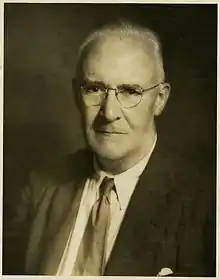Harold A. Wilson (physicist)
Harold Albert Wilson FRS[2] (1 December 1874 – 1964) was an English physicist.[3]
Harold Wilson | |
|---|---|
 Wilson in 1939 | |
| Born | Harold Albert Wilson 1 December 1874 |
| Died | 13 October 1964 (aged 89) |
| Awards | Fellow of the Royal Society[1] |
| Scientific career | |
| Institutions | University of Cambridge University of Leeds King's College London Rice University Cavendish Laboratory University of Glasgow McGill University |
Early life
Wilson was born in York, the son of Albert William Wilson, a goods manager with the North British Railway.[4] His mother, Anne Gill, was the daughter of a farmer and innkeeper from Topcliffe.
Wilson was educated at St Olave's Grammar School. He then studied science at Victoria University College in Leeds and then at University College, London, graduating BSc in 1896. He then went to Cambridge University and gained a BA and DSc.[2]
Career
In 1896, he became a colleague of English physicist J. J. Thomson at Cambridge University, and performed one of the earliest measurements of the electron's charge. He was awarded his Doctor of Science degree from London in 1900, and was elected Fellow of Trinity College, Cambridge in October 1901.[5] From 1901 to 1904, he held a James Clerk Maxwell fellowship at the Cavendish Laboratory. He became a lecturer in Physics at King's College London, then professor at the college in 1905. In 1906, he was elected a Fellow of the Royal Society of London (FRS).
In 1909, he accepted a role as professor of Physics at McGill University in Montreal in Canada, staying there three years.
He joined the Rice Institute located in Houston, Texas in 1912, becoming the first chair of the physics department. He was one of the original 12 founding professors.[6]
He returned to Britain in 1924, spending a year at the University of Glasgow. In 1925 he was elected a Fellow of the Royal Society of Edinburgh. His proposers were Charles Glover Barkla, Frederick Orpen Bower, John Walter Gregory and Sir John Graham Kerr.[2]
In 1925, he returned to Rice University in Houston (also working as a consultant to an oil company) and continued there until retiral in 1947.
Family
In 1912, he married Marjorie Patterson Smyth.[2]
Harold had one sister, Lilian, who would marry Sir Owen W. Richardson.
Recognition
The Wilson Award at Rice University is named after him.[8]
Publications
- Electrical Conductivity of Flames (1912)
- Experimental Physics (1915)
- Modern Physics (1928)
- Mysteries of the Atom (1934)
References
- Thomson, G. P. (1965). "Harold Albert Wilson 1874-1964". Biographical Memoirs of Fellows of the Royal Society. 11: 186–201. doi:10.1098/rsbm.1965.0013.
- Biographical Index of Former Fellows of the Royal Society of Edinburgh 1783–2002 (PDF). The Royal Society of Edinburgh. July 2006. ISBN 978-0-902198-84-5. Archived from the original (PDF) on 4 March 2016. Retrieved 18 July 2019.
- "Biography of Harold Wilson". University of Glasgow. Retrieved 2 September 2008.
- Harold A. Wilson Fellows of the Royal Society
- "University intelligence - Cambridge". The Times. No. 36583. London. 11 October 1901. p. 4.
- "Dr Harold Wilson, A‐Bomb Physicist, 89". The New York Times. 13 October 1964.
- "Wilson, Harold Albert | Encyclopedia.com".
- "Awards in Physics and Astronomy". Rice University. Retrieved 31 March 2012.